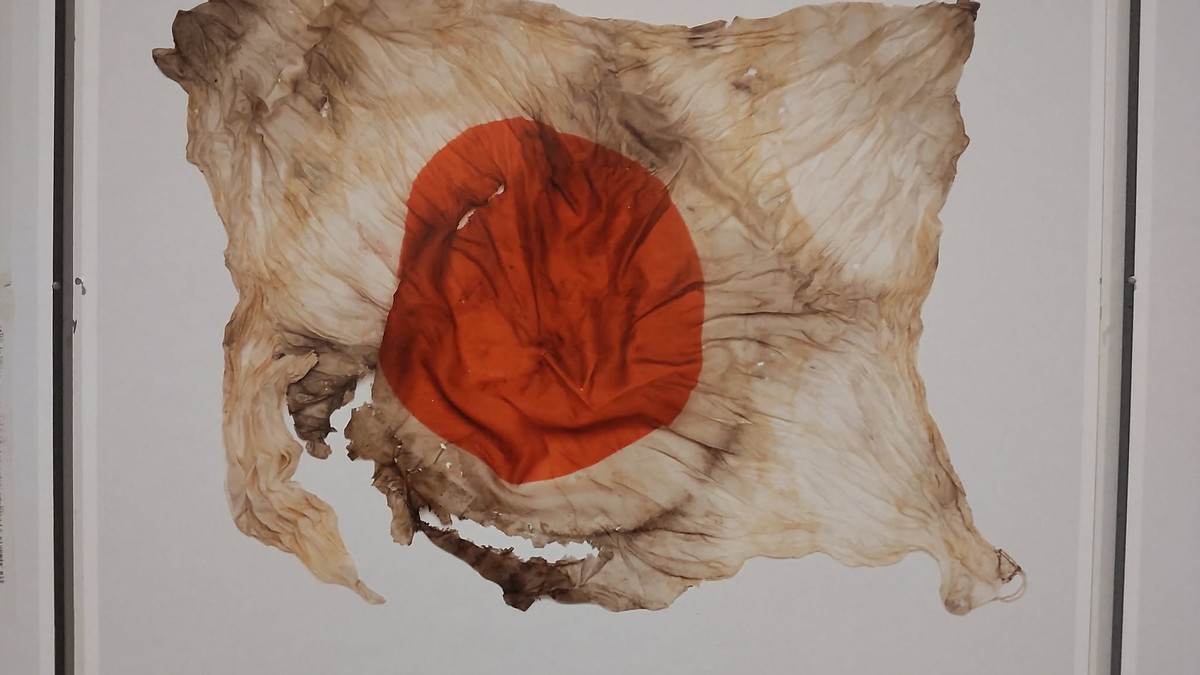
August 15th was the war-end anniversary in Japan. On this day, the Empire of Japan surrendered in World War II. Eighty years has passed since then. Both of my parents lived through the war, but either my husband nor I know what it was really like. We only learned about the terrible war in school.
On the 15th, I visited a museum in Osaka to see pictures related to Hiroshima atomic bombing. My country is the only one ever attacked with the atomic bombs by the U.S., and both Hiroshima City and Nagasaki City were completely destroyed. Around 21,000 innocent people became victims.
The show features only the photographs of the war victims' belongings, and it caused much more sadness because even though the owners had been gone, their possessions still remain, saliently telling their own stories.

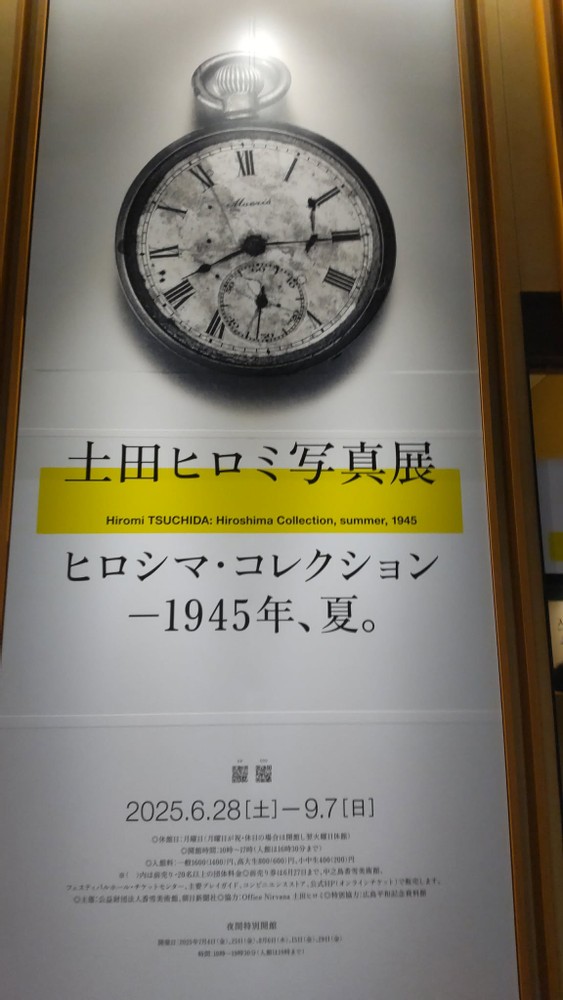
In the poster you see a pocket watch pointing at 8:15, which was the exact time the atomic bomb dropped on August 6th.
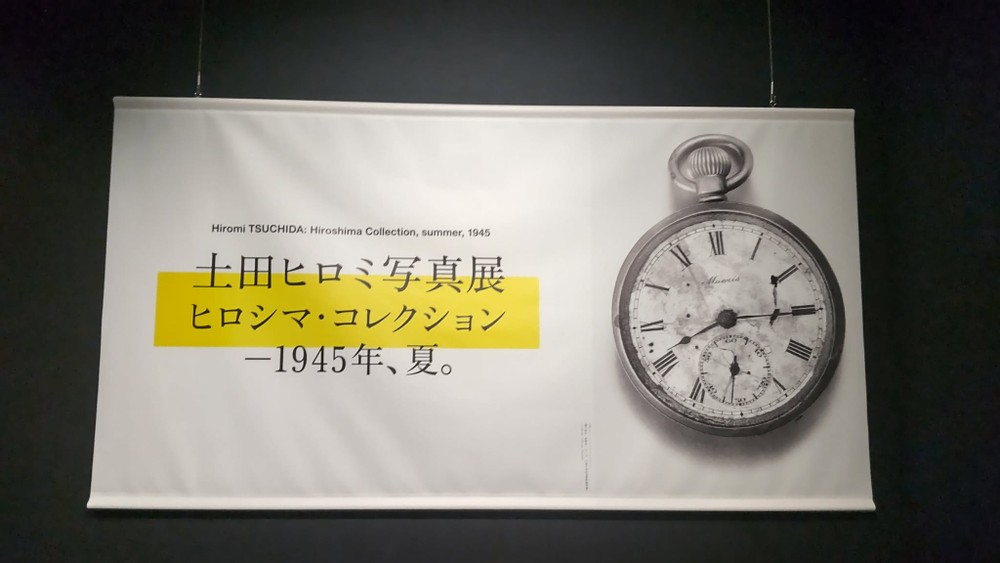
You see the portrait of the photographer, Hiromi Tsuchida.
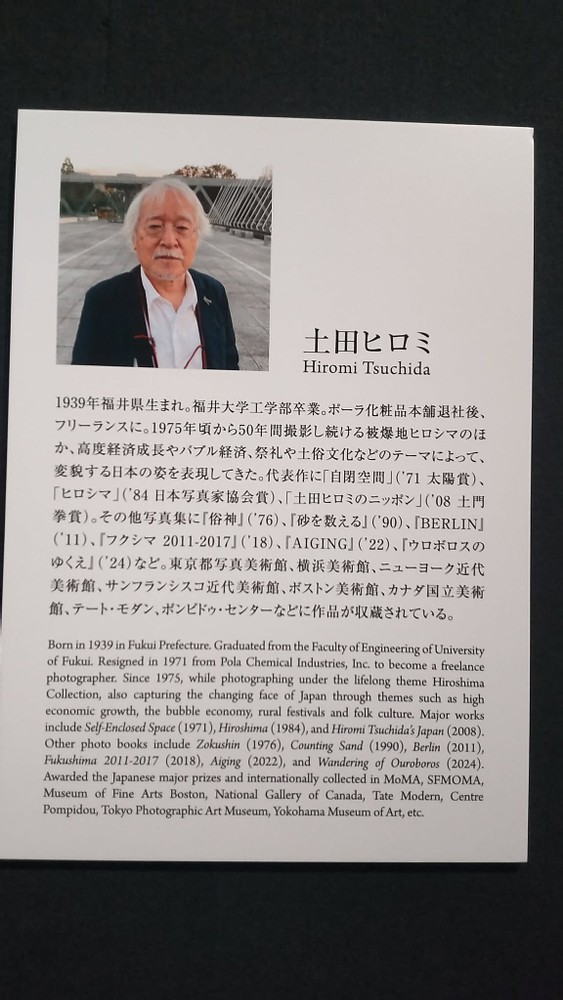
Each photo came with a short story and reading them broke my heart. They explained whose belongings they are, how the owners died, how the items were found, how they were kept, and more. Girls and boys were wearing those outfits on that day. Fortunately, a few managed to survive, but most of them were dead. Before dying, many lost all their teeth and hair. Some bled from gums. Even the survives, some had to suffer from cancers for a long time. There was a strange rumor among the victim families, and even though patients craved water, they believed that water would kill them. So, they never gave it to them, and some were going to die desperately thirsty.
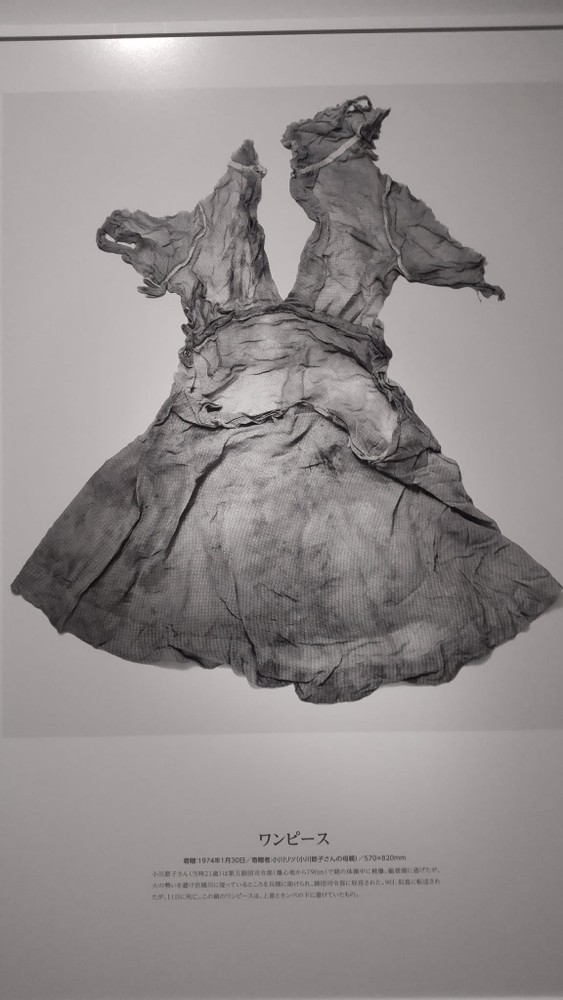
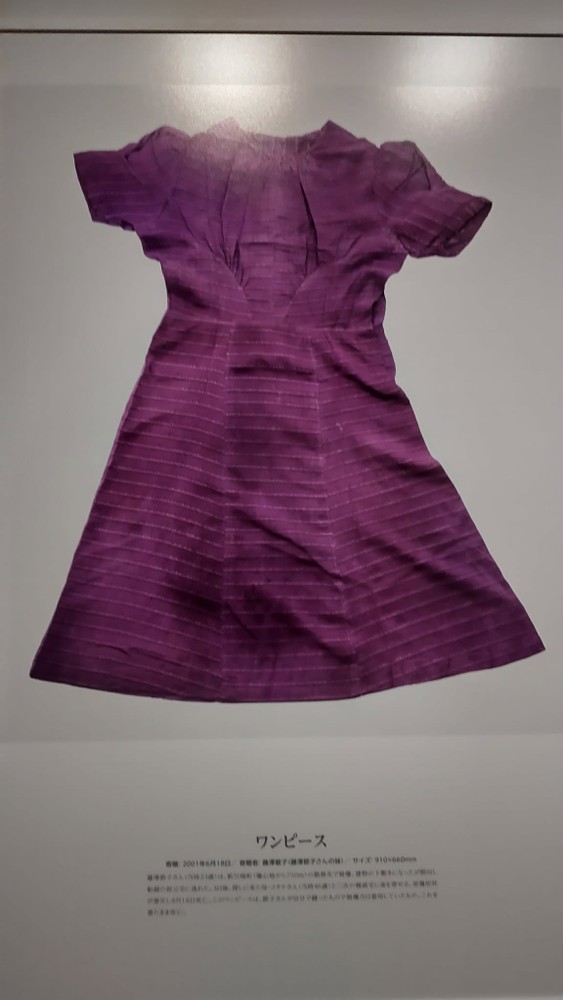
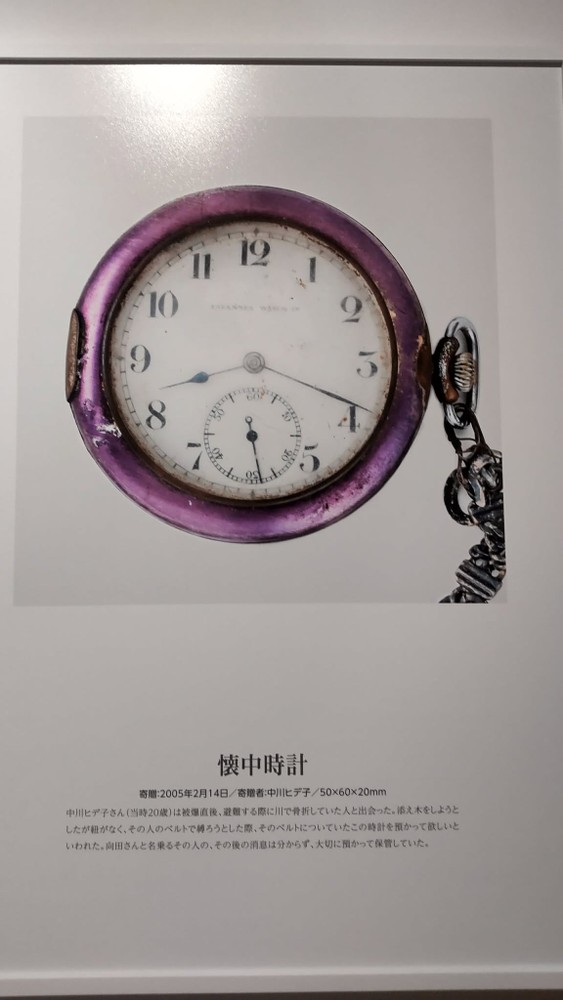
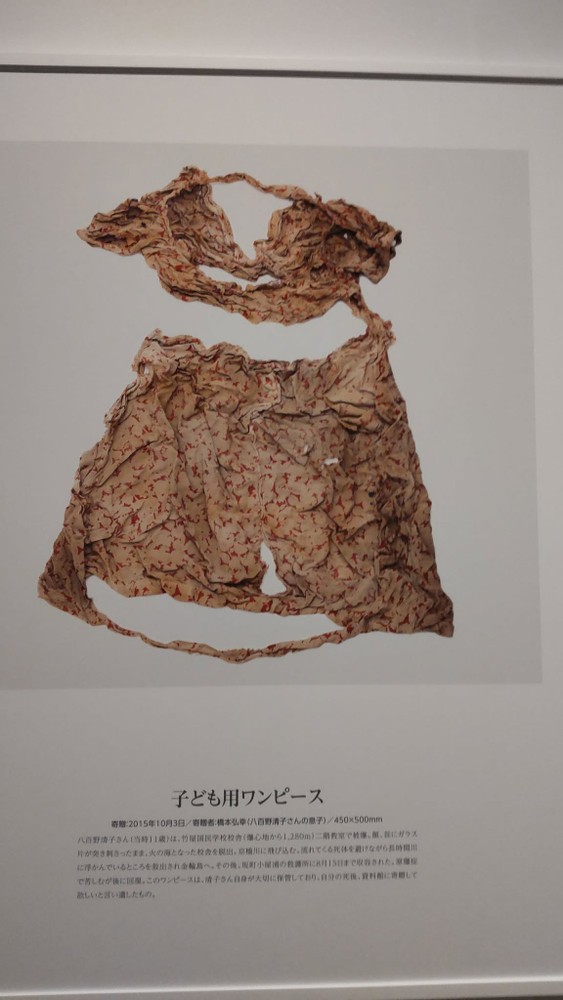
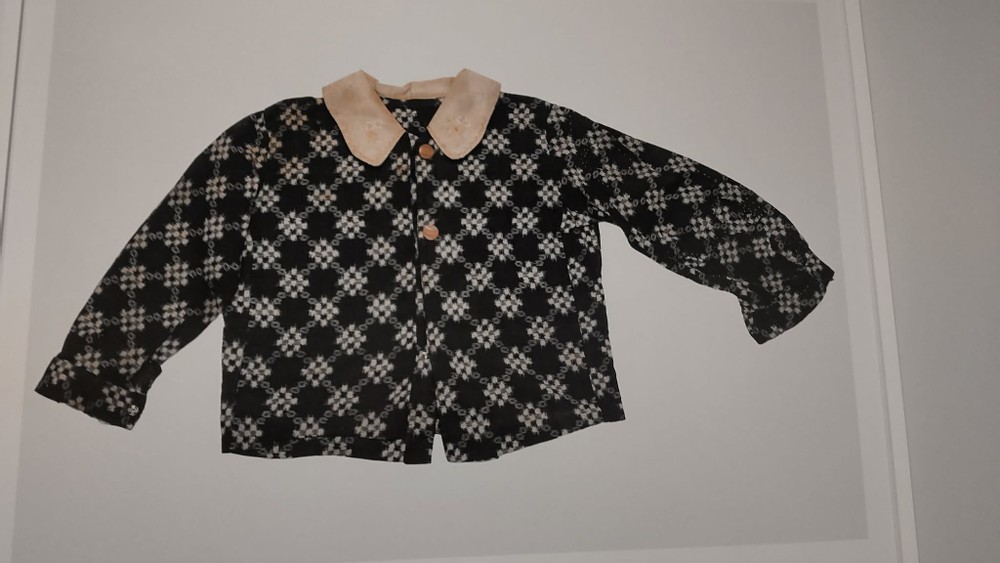
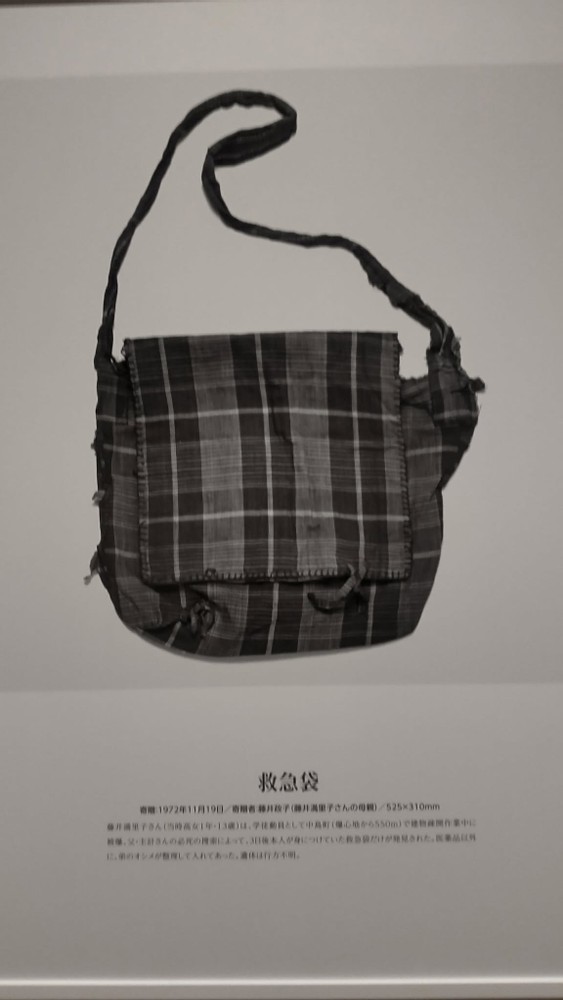
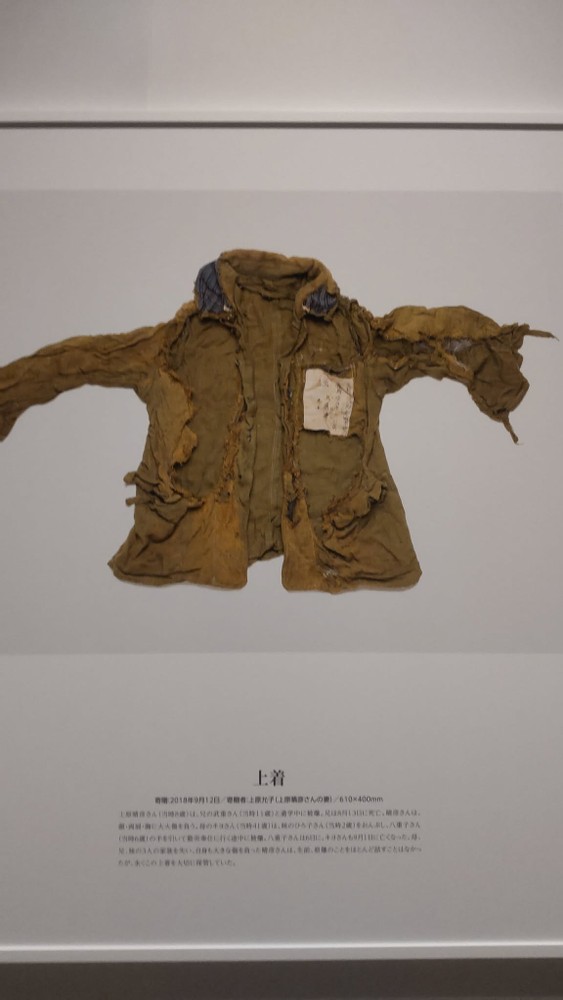
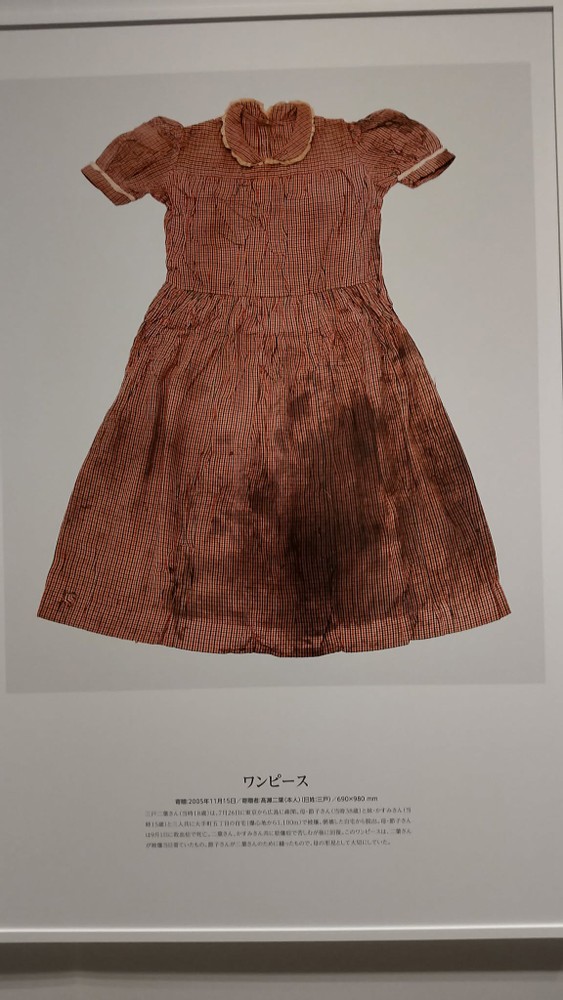

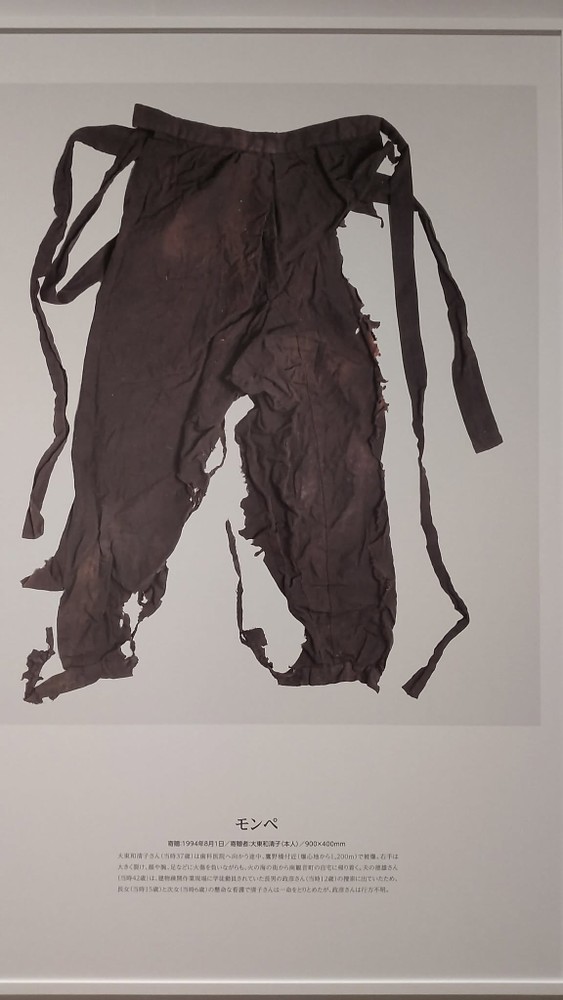
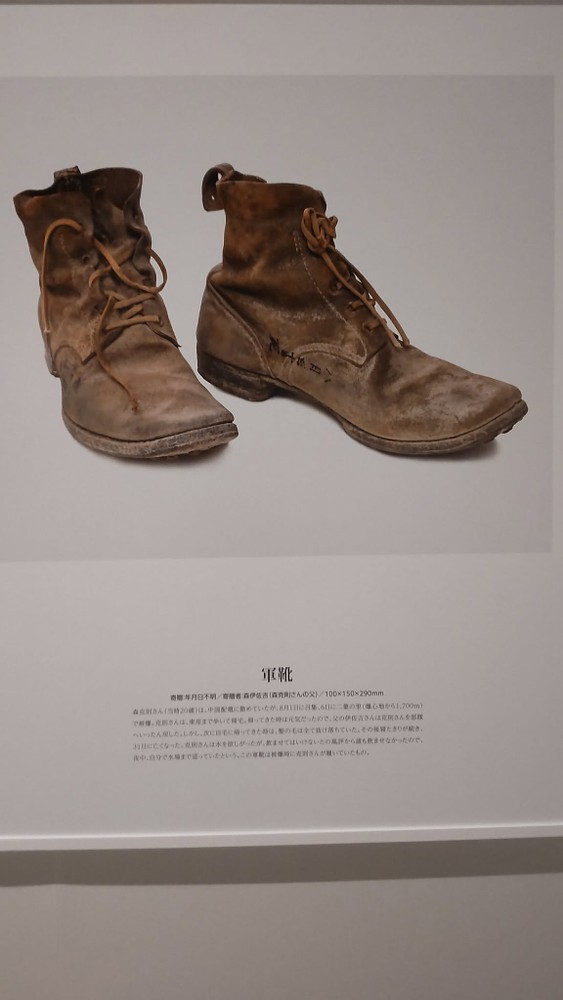
The picture below shows Hiroshima completely destroyed after the bombing, and Hiroshima now.
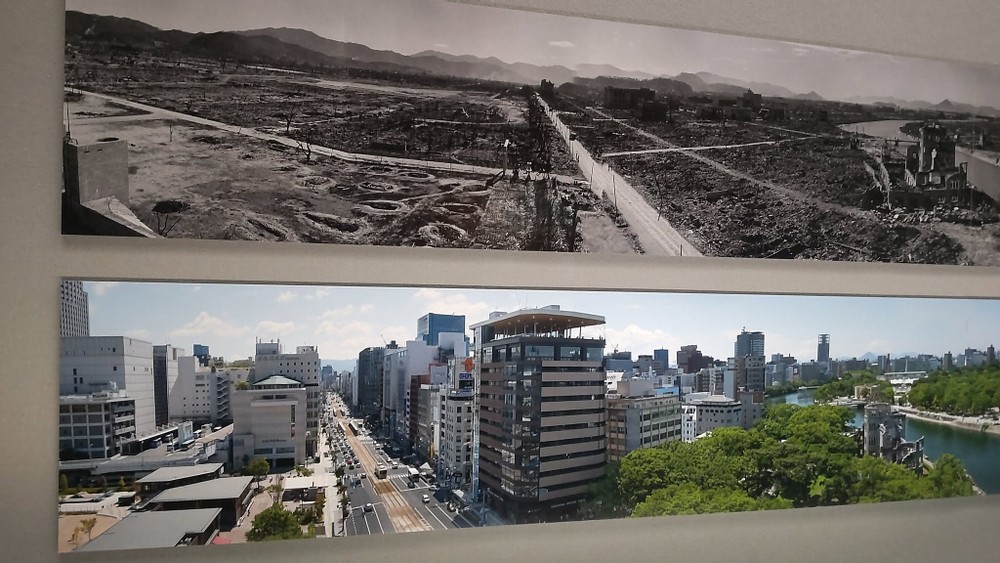
There were lots of bento box photos, but I'll show you only few here. These bento were never eaten by their owners and even now they seem to be waiting. Most of food became carbonized immediately.
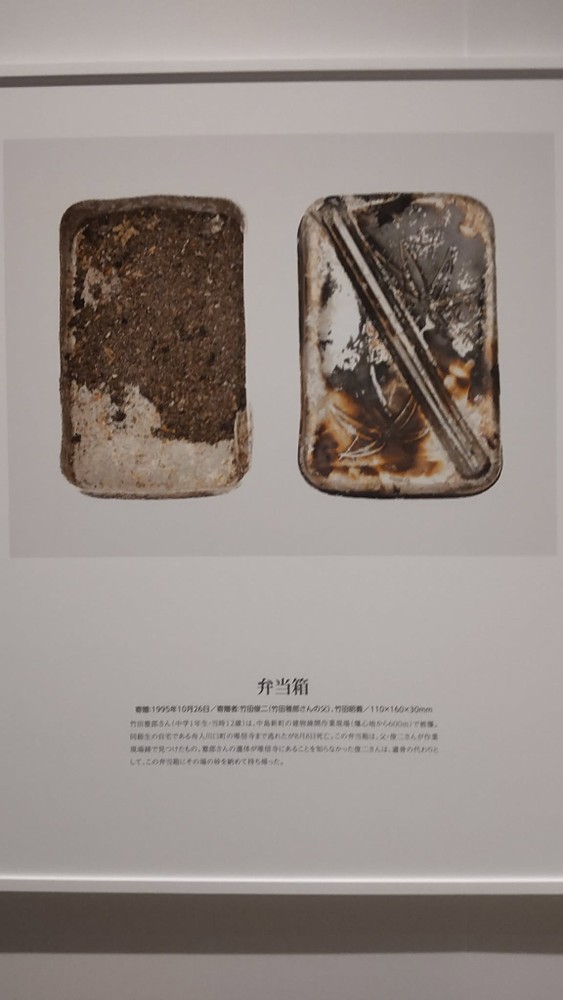
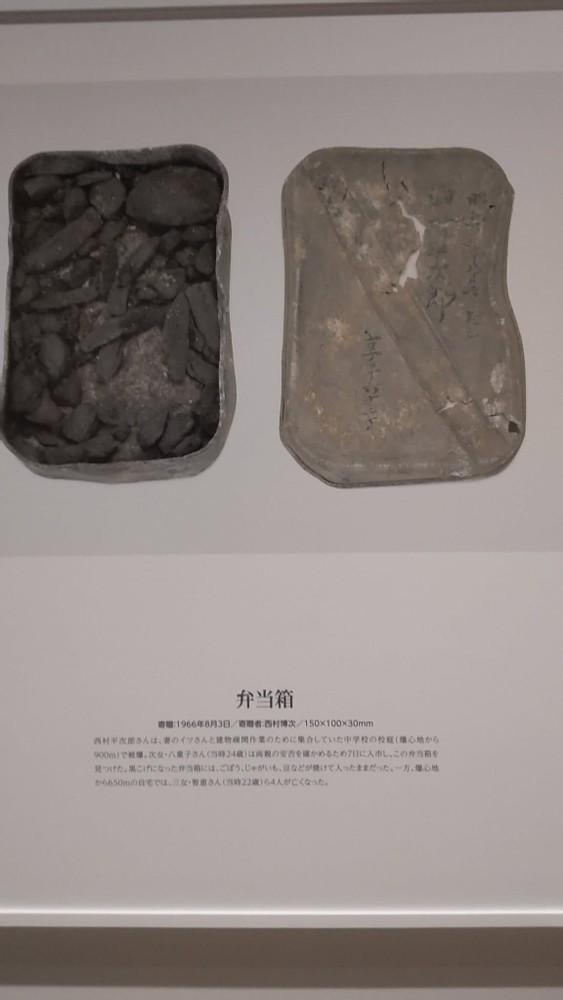

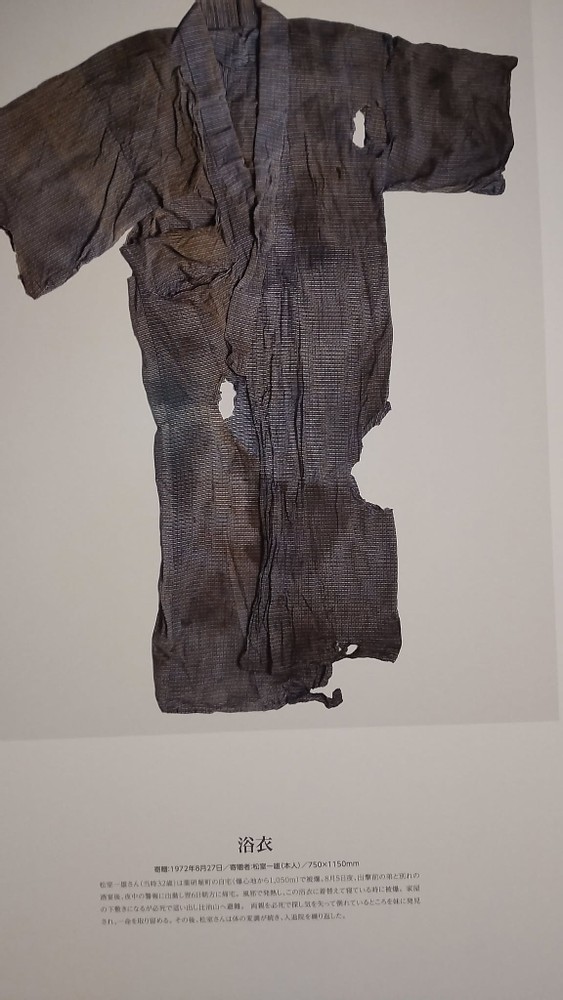
A Shirley Temple doll, which was sent to a daughter from a father who lived in the US in 1930.
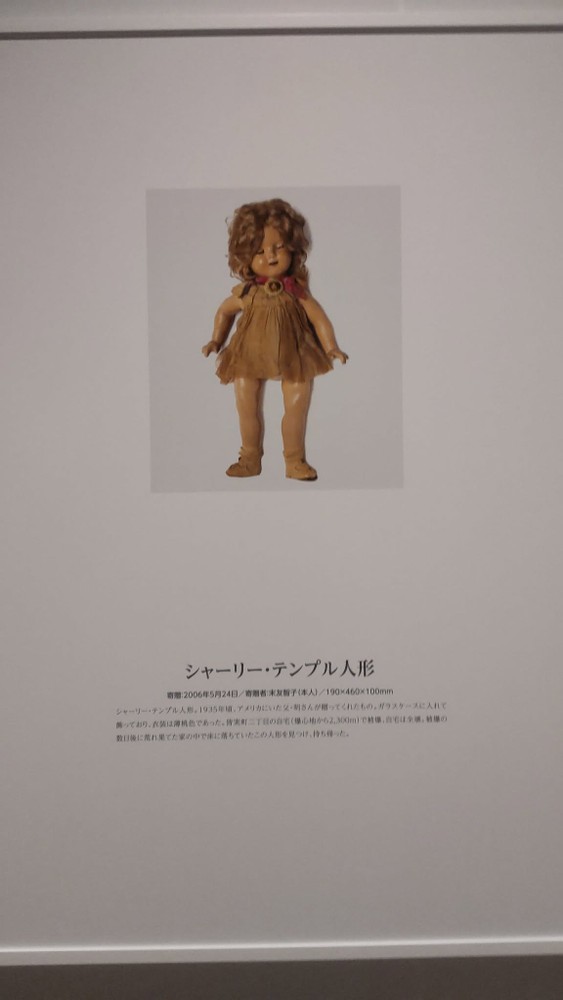
A school uniform for a female student.
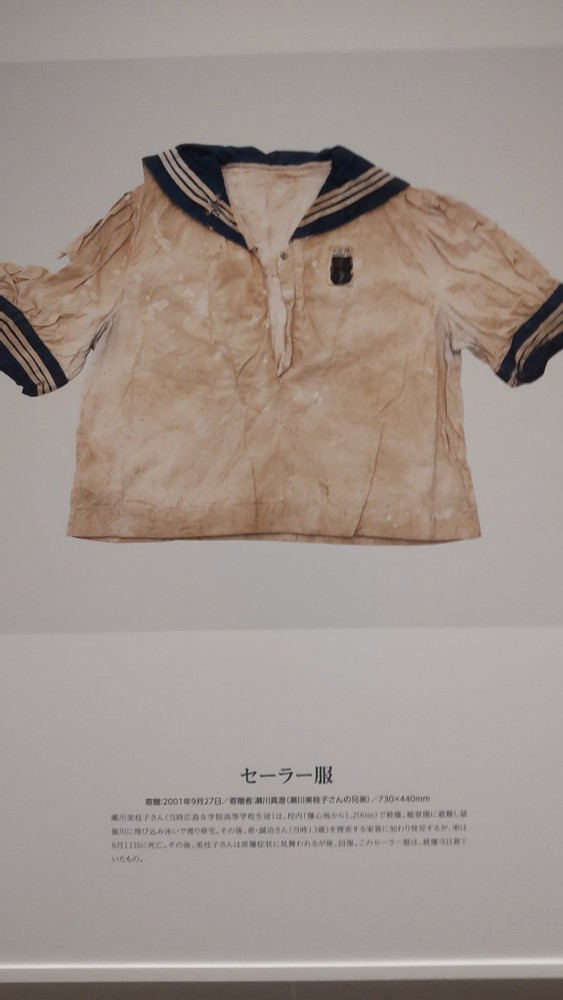
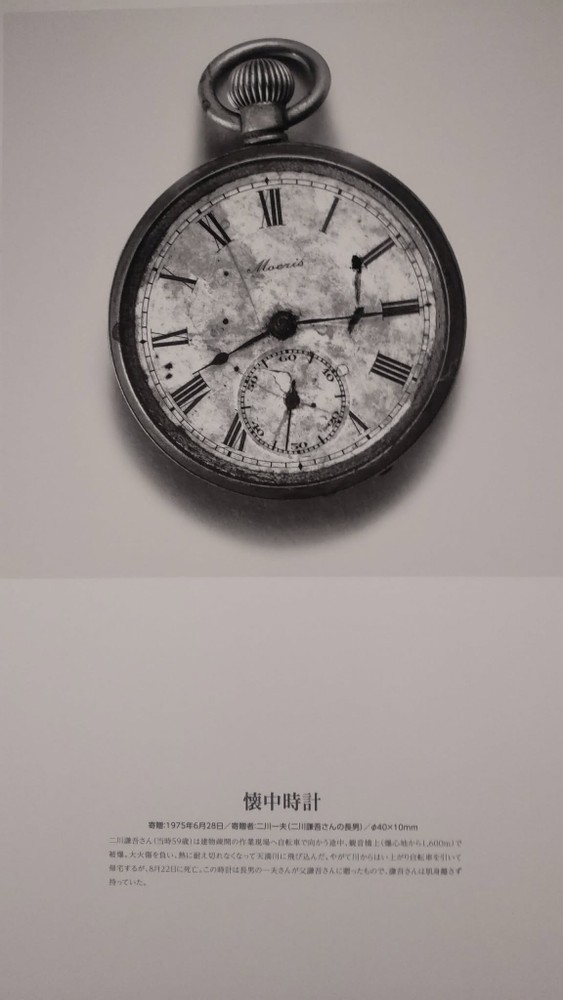
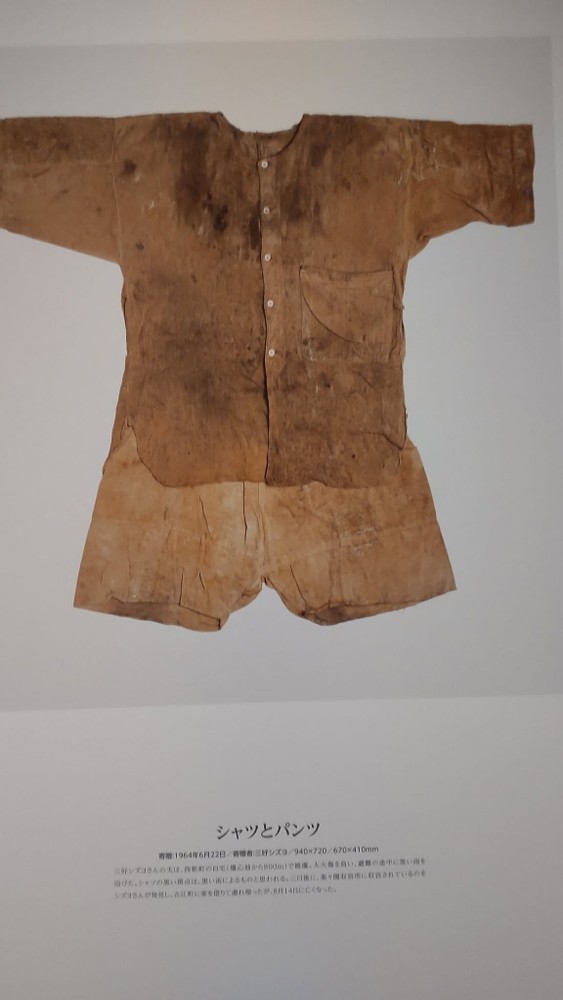
A pair of glasses, which were stuck to a skull of the victim. The other half were melted with the part of the skull.
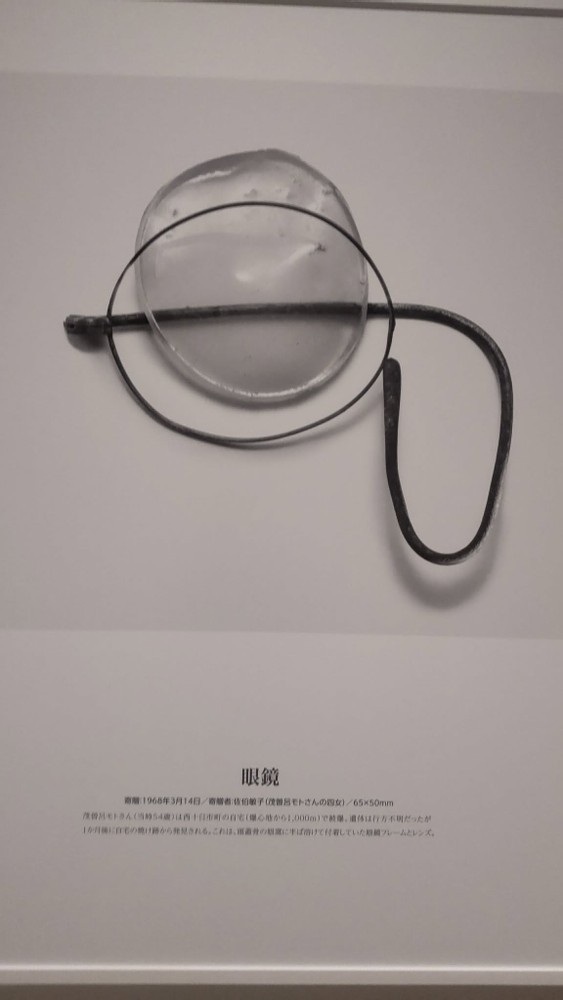
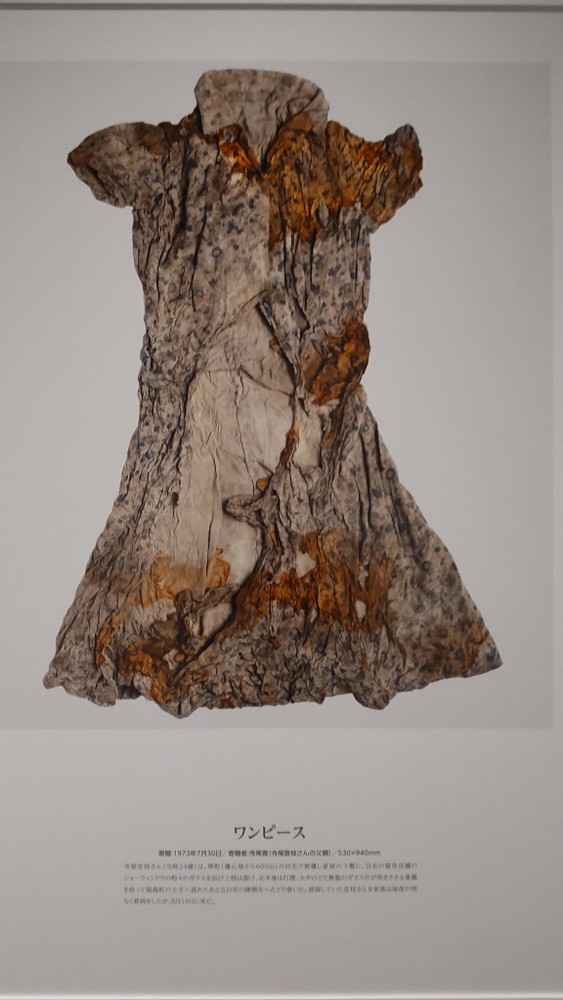

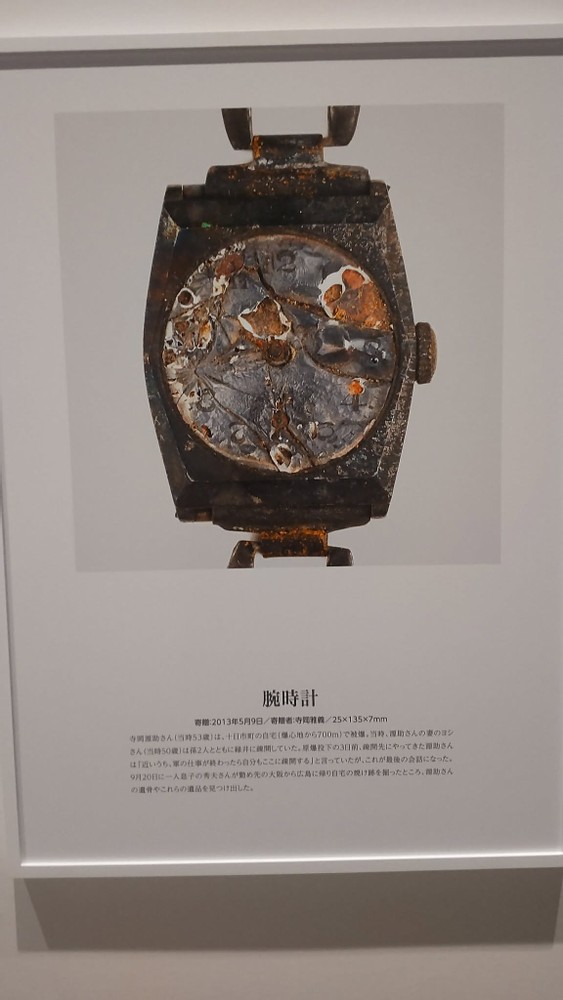
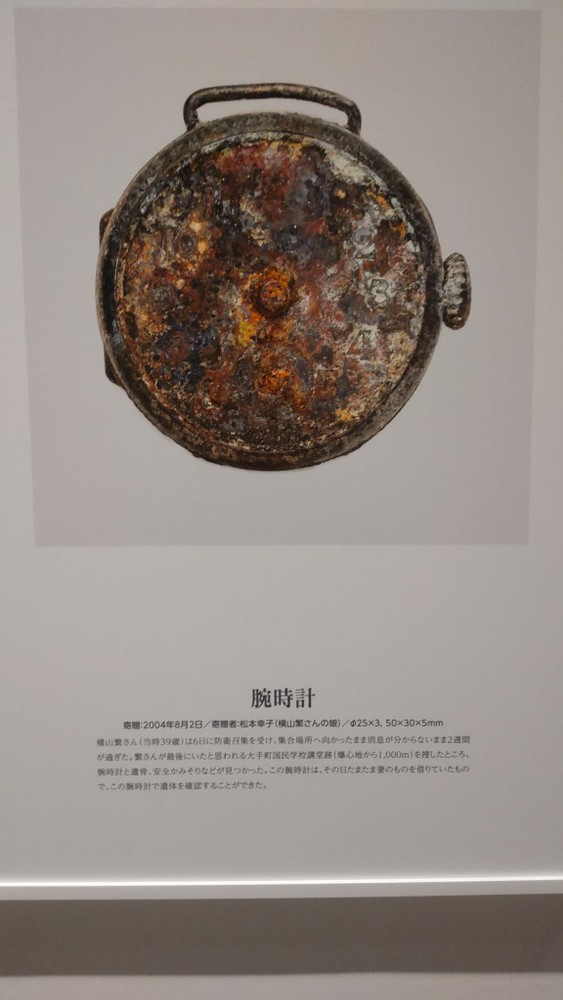
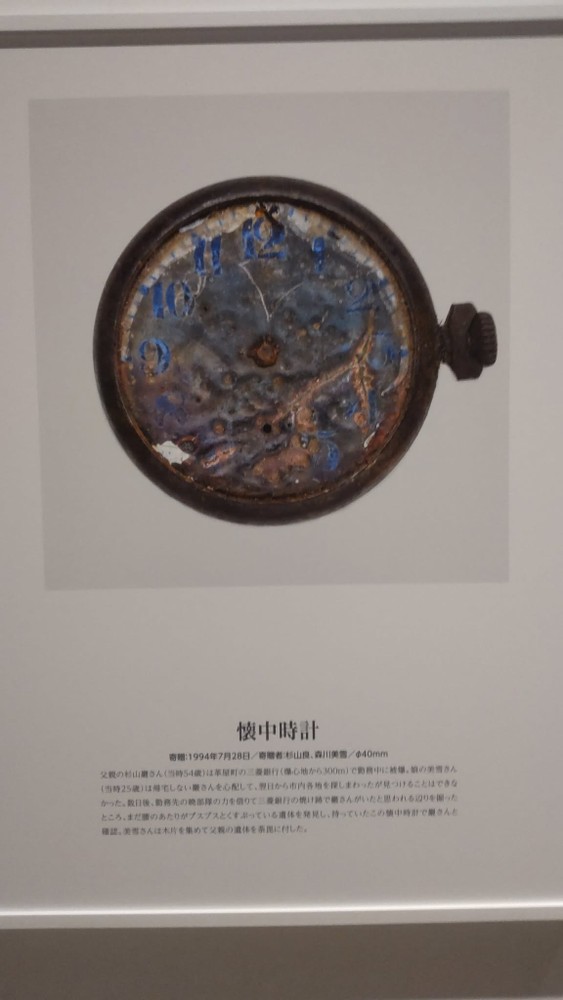
A pair of uniform trousers for a Japanese soldier.
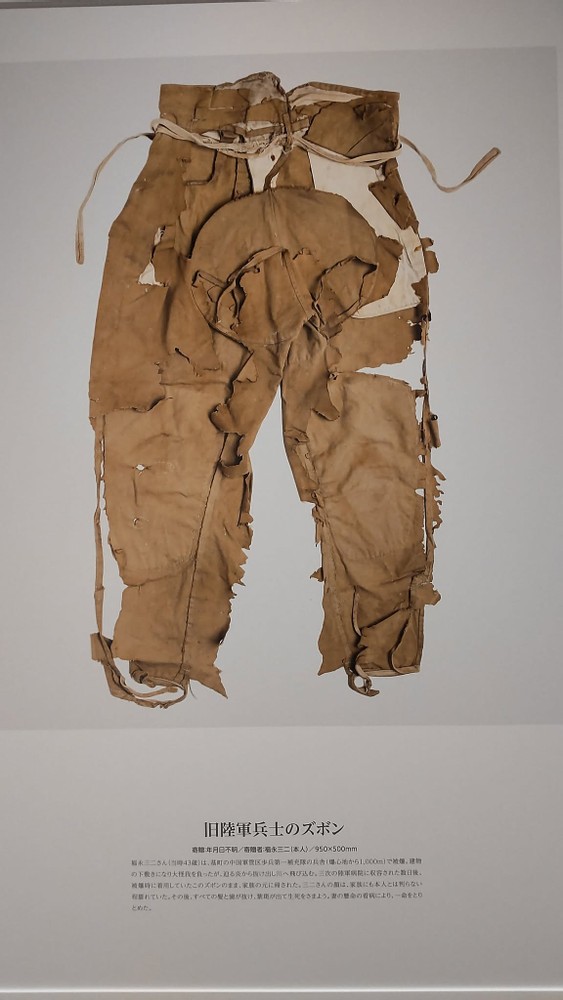
Hair: When a mother combed her daughter's hair three times, the front hair felt off. She kept it as a moment.
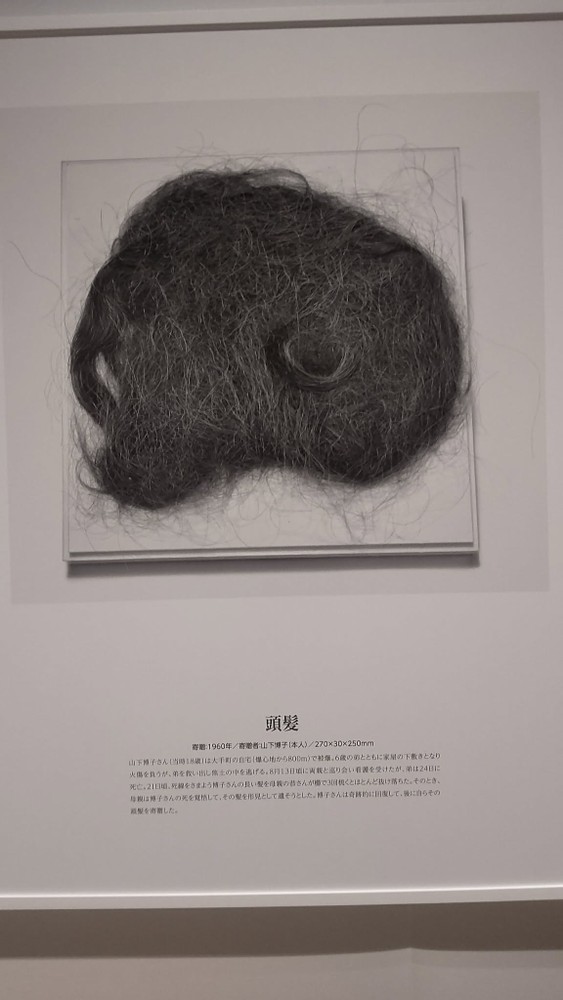
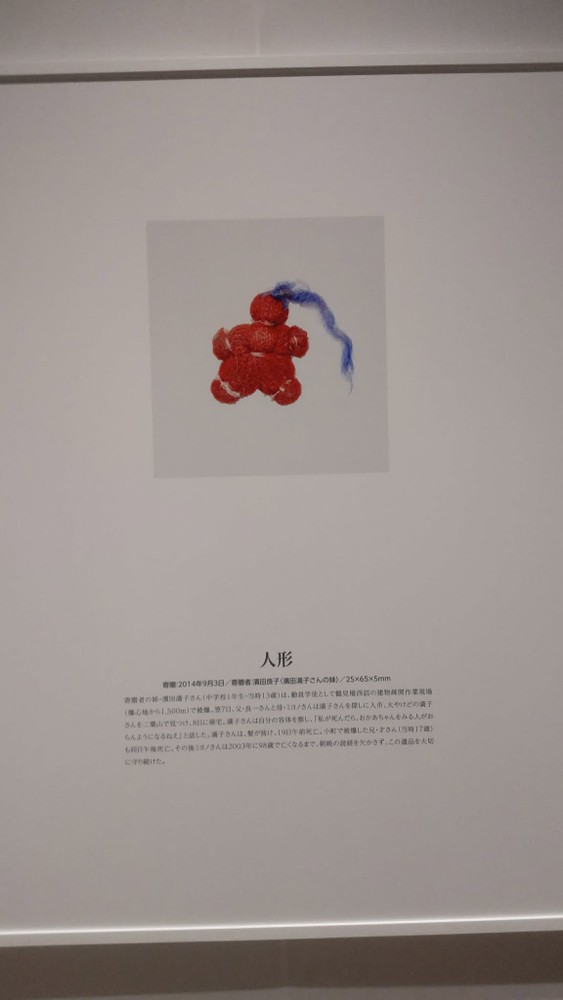
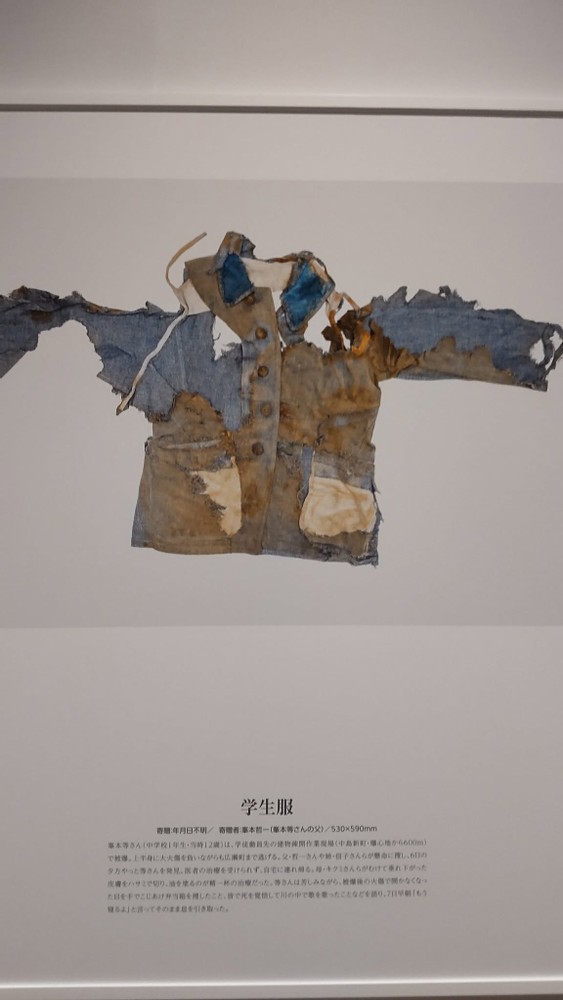
A Nurse's uniform.
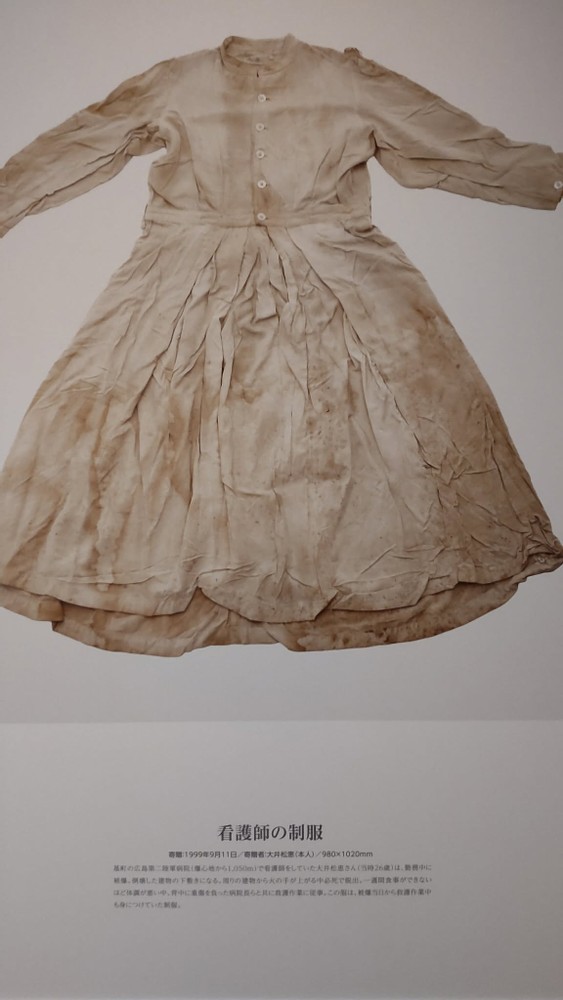
Nail: a 26-year-old guy burned on his right arm while reaching out of the window. Since then, his right nail turned black and kept growing. Since the nail created blood vessel in it, he couldn't cut the nail. Even though it was broke, the same black nail started growing.
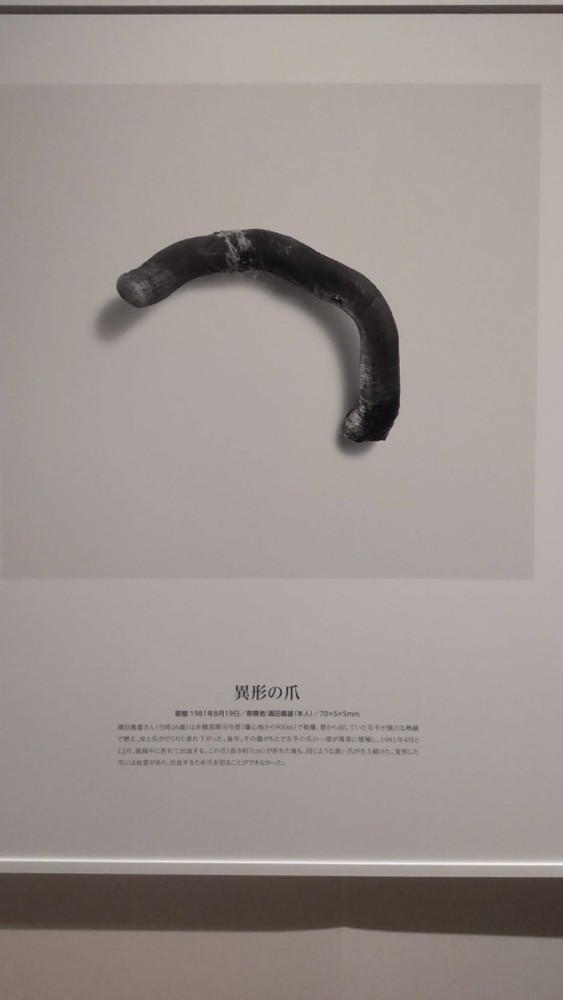
A melted Buddha statue.

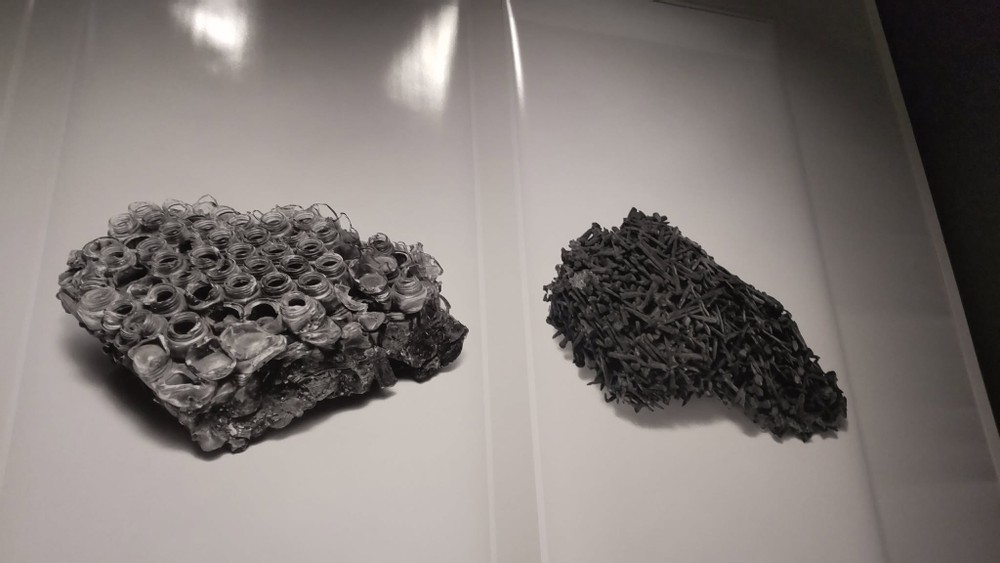
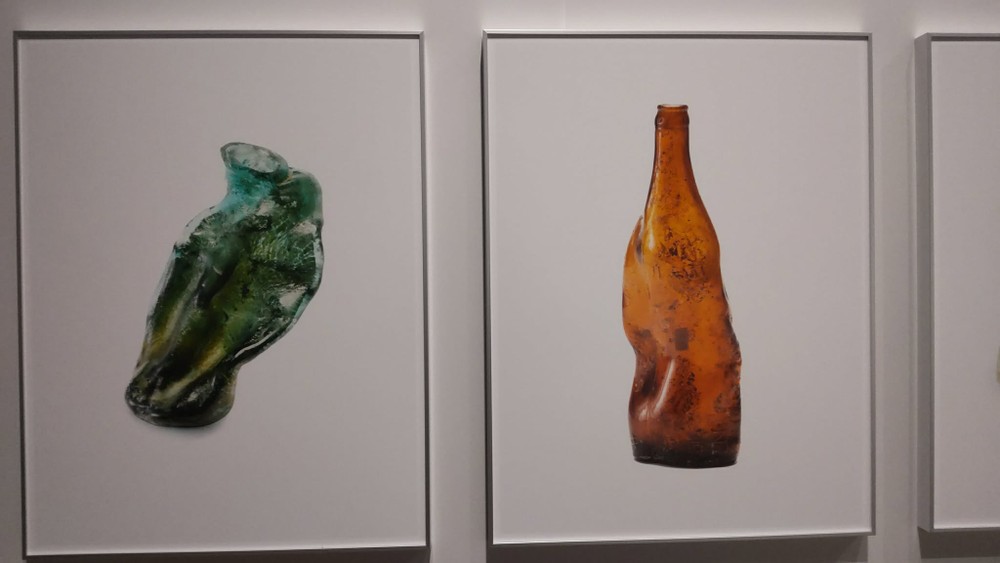

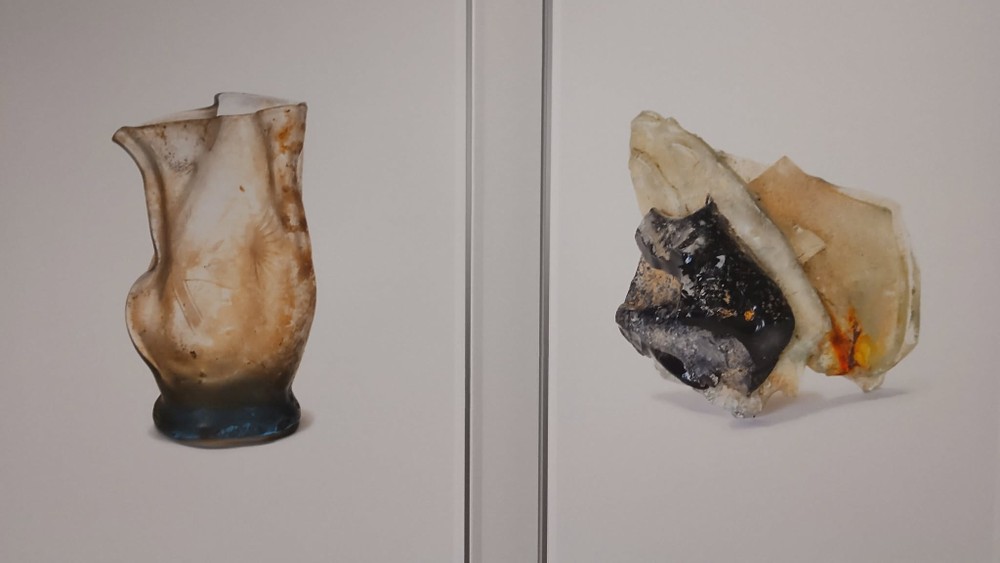
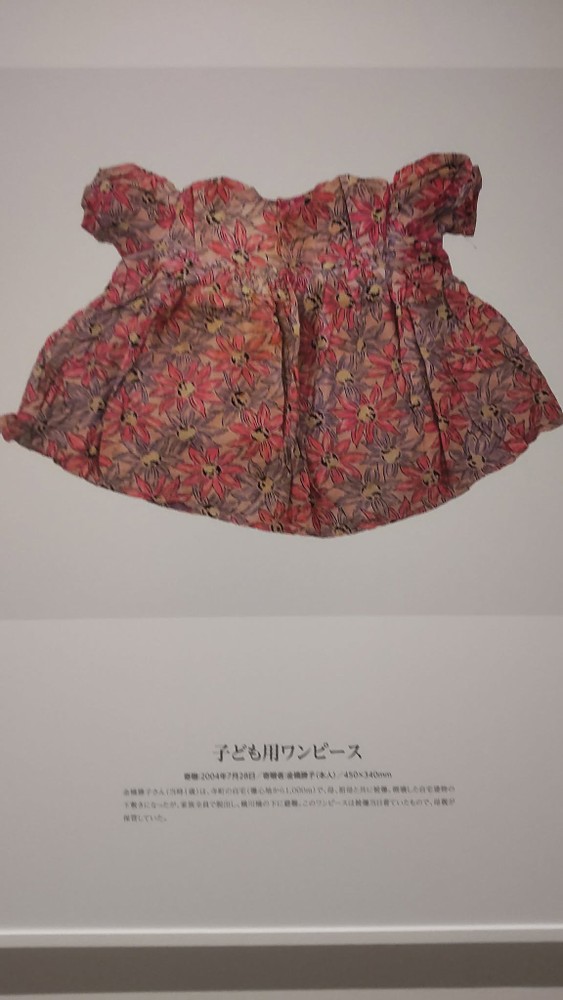
A geta sandal (a type of shoe) worn by 13-year-old girl. Her mother kept looking for her since then and finally found this one after two months. She remembered the strap pattern of the geta because it was made by a part of her kimono. It got her daughter's footprint still on it, but her daughter's body was never found.
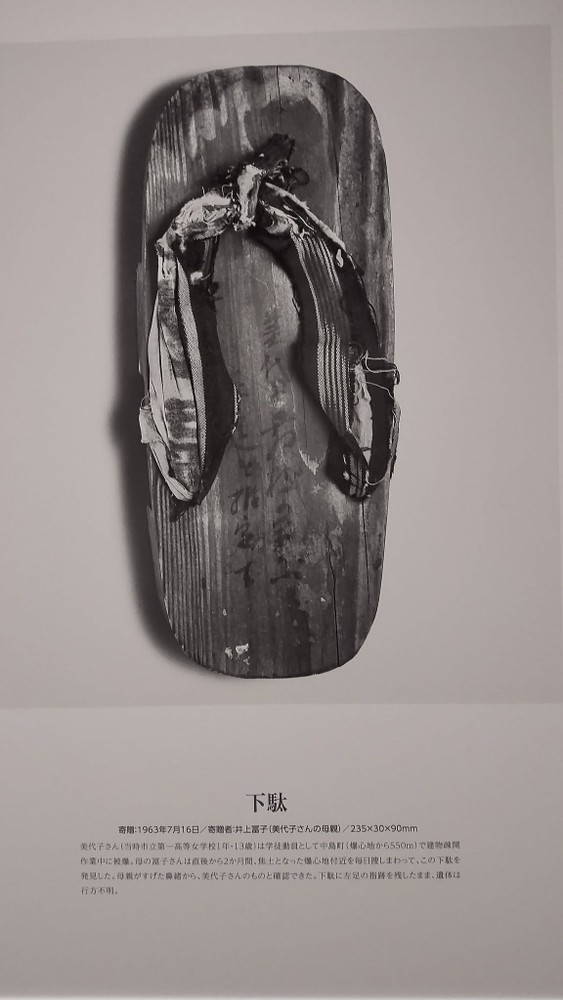
A school uniform for a male student: His father found it hanging on a branch of a tree, but he couldn't find his son's corpse.

A board game
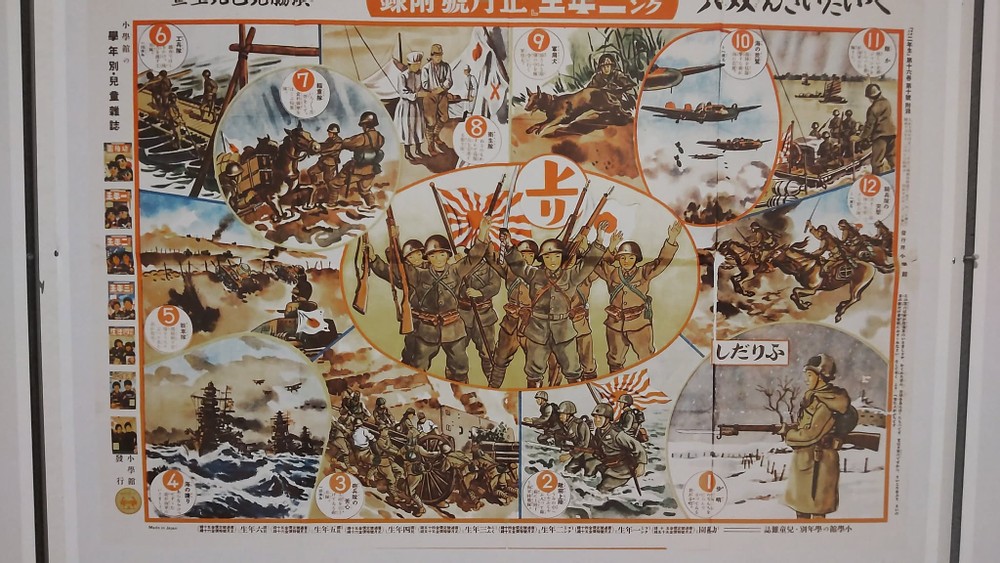
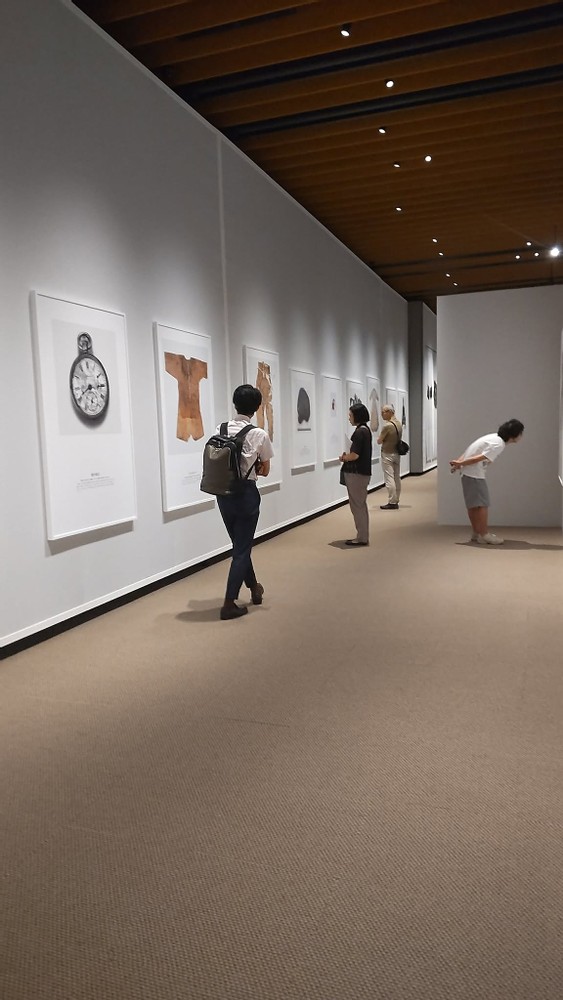
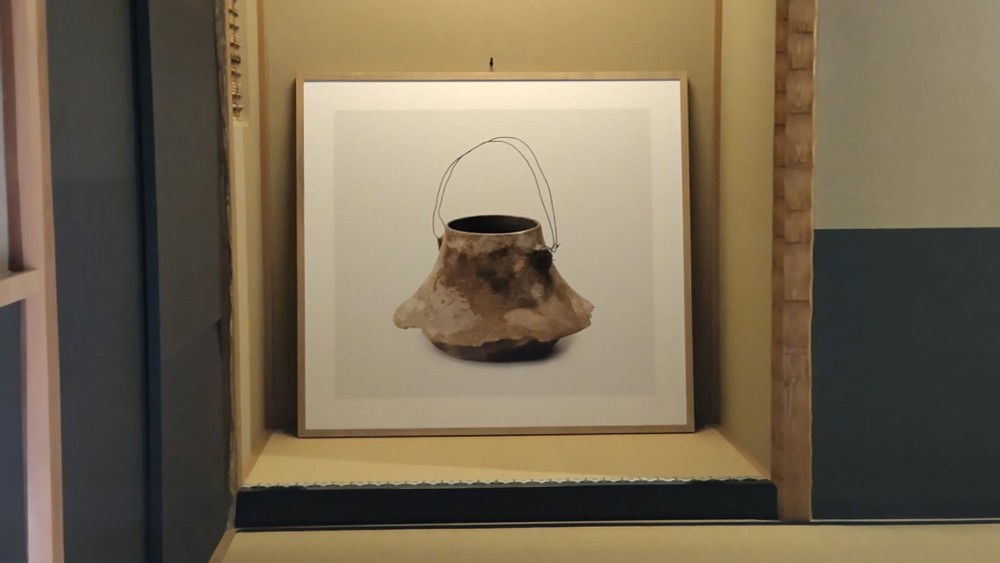

After the exhibition, I overlooked downtown Osaka through a window. I truly appreciated how fortunate I am to have been been born in such peaceful Japan.
Those belongings have been waiting for their owners, who will never return, for 80 years. When I thought it, I felt unbearable.
These items' owners were mostly boys and girls who should have had bright futures, but everything was destroyed in a second. They didn't kill enemies, and they were innocent citizens who simply believed in Japan's victory.
I want you to know about Hiroshima and how awful atomic bombs are. Wars create nothing and only bring despair.
Even today, somewhere in the world, wars continue, and innocent people are still becoming victims. Atomic bombs today are 80 times more powerful than the one dropped on Hiroshima. Japan made tremendous sacrifices, yet wars still go on. I don't want to think their deaths were waste.
Why do we still keep wars? Why can't we stop them? Why don't we learn from the past?
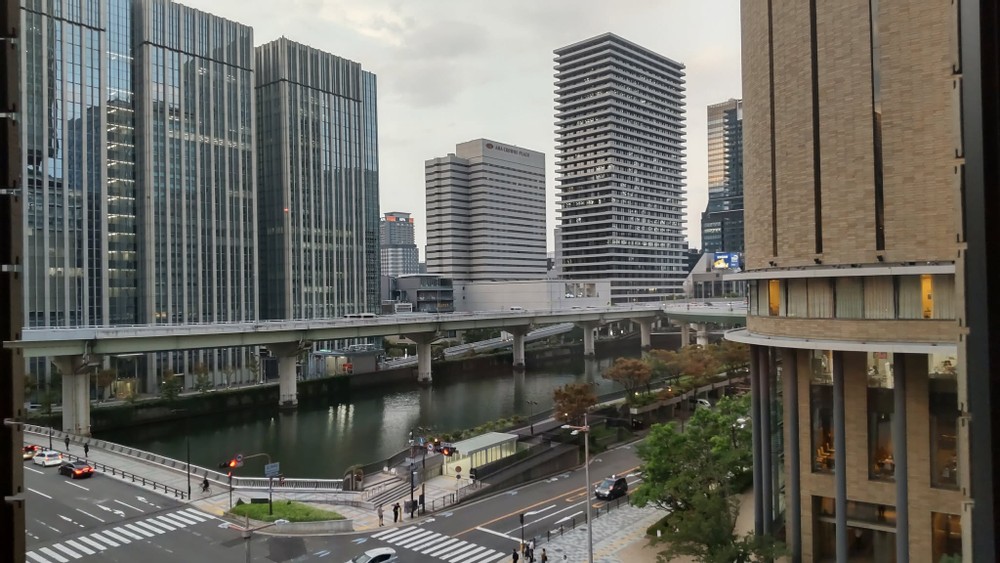
If you are curious about Hiroshima and Nagasaki atomic bombing, you can read more here.
If you are interested in Hiroshima atomic bombing, you can watch a documentary here.
(4982)
How sad! The U.S. wanted a quick end to the war, but I wonder why it chose to use a nuclear bomb, which no other nation has ever used. I would think it knew of the harmful effects and deaths it would cause.
I think we still have wars because of territorial disputes, egos, greed, power struggles, economic tensions, and more. But what is actually resolved?
Another shameful act happened when "the United States forcibly relocated and incarcerated about 120,000 people of Japanese descent in ten concentration camps located mostly in the western interior of the [U.S.]. About two-thirds were U.S. citizens." Japanese families lived in deplorable, crowded conditions in the camps. Their incarceration happened because of race prejudice and war hysteria, according to a later government report. https://en.wikipedia.org/wiki/Internment_of_Japanese_Americans
It's encouraging that Japan has this exhibit. While the U.S. government is trying to erase history, to whitewash it, Japan keeps these horrific events alive. The saying, "Those who cannot remember the past are condemned to repeat it" is fitting here. It emphasizes the importance of understanding history to avoid making the same mistakes again.
I'm pretty sure that the history of the internment of Japanese Americans and the nuclear bombing of Hiroshima and Nagasaki will be sanitized or removed from exhibits and textbooks in the US, much as the United States' history of slavery is being removed from school curricula.
A word to describe such an exhibition would be 'poignant' https://dictionary.cambridge.org/dictionary/english/poignant
I think it was all about fear... no one wanted to be the one that 'lost'. I love how Japan bounced back from the war.
Thanks for this enlightening post, Yumi!
Here's an interesting article that explains the role of U.S. imperisalism. the key words are: global solidarity and relentless struggle. https://mondoweiss.net/2025/08/how-u-s-imperialism-blackmails-the-world-with-nuclear-weapons-from-hiroshima-to-today/
"The solution is not to impose disarmament on oppressed nations, but the complete dismantling of the imperialist war machine and its nuclear terror apparatus, which must start with the U.S. Because the U.S. will never voluntarily give up its biggest guns, true peace can only come through the total defeat of U.S. imperialism and its junior partners, a victory that will require global solidarity and relentless struggle for just peace."
@SEQ77 Thank you so much for the correcting, reading and commenting. I've heard about the labor camp, but I don't know about it well. Thank you for the link.
I've known what's going on in the States through my friends from Texas. He's often shared political events, and some historical monuments were destroyed or removed. But I didn't know that slavery or Hiroshima might erase from school textbooks. That's really sad. I support what you wrote here. We definitely should keep these evidences and pass these to later generations.
@via-chan Thank you for teaching a new word. My American friend and I sometimes talk about why they were dropped on Japan. I think they really wanted to test them, but they couldn't drop them on Europe because most of American citizens were from the area. It would cause huge blame then. They also wanted to compete Soviet Union to show off what powerful weapons they had. As SEQ77 mentioned that they wanted to end the war quick, and that's also one of the reasons. Off course, nobody wants to become a looser.
@Double-Zee Thank you for the link, which seems very interesting to read. I'd love to share it with my American friends.
I still believe making friends with people from over the world and understanding them will help stop wars. Japan once was a enemy of America, but now my country is one of their best allays. They destroyed us, but they helped us a lot to rebuilt. If my country was colonized by the other side (Soviet Union), Japan would never be like now. So, even though we were completely destroyed, I still appreciate America. I think my thoughts relate to our education.
I don't like China and North Korea (both have nuclear weapons)attack us when American loose their power. It might happen in Asia. I think we still need American as a police officer here. They've been watching these counties and that's why we are safe here.
Things are very complex, aren't they?
@yumiyumayume The Trump administration's executive orders, with a focus on "patriotic education," have been criticized by some historians and educators for potentially promoting a biased, revisionist view of American history, including downplaying the role of slavery (and I'm assuming the bombing of Hiroshima and Nagasaki). The federal government doesn't directly control school curriculum; states and local school districts retain that authority, but school districts, fearing losing funding from the government, may be pressured to eliminate aspects of American history that don't align with a particular political view. The administration is now conducting a review of the exhibits and materials at the Smithsonian Institution, the agency that organizes eleven museums, to make sure that their exhibits and material align with the president's vision of American history, and will be "a place for families and children to celebrate American history and greatness."
I'm pretty clueless about history, so I looked for a resource that could explain why WWII began and why Japan, the United States, and other countries were involved. I found the following to be helpful: https://www.history.com/topics/world-war-ii
"They destroyed us, but they helped us a lot to rebuilt."
That's really interesting! I might write about it. I think the article highlighted this point. The U.S. has a lot of nuclear weapons. Most of the other countries try to have nuclear weapons to protect themselves against the US.
"The DPRK’s nuclear program is a direct response to decades of U.S. hostility, a deterrence forged in the fires of threats and direct war on its people. During the Korean War (1950–53), U.S. bombing killed 20% of the North’s population and razed more cities than in Japan or Germany during WWII, to the point that U.S. generals admitted “there are no more targets left in Korea.” The war itself ended with an armistice but no peace agreement to this day, leaving the U.S. still technically in a state of war with the DPRK. This forced the country to pursue any and all forms of defense against further foreign aggression against its people.
"Today, the U.S. escalates tensions with reckless military drills near the DPRK’s border, even deploying B-1B bombers capable of nuclear strikes. The DPRK has repeatedly offered to halt missile tests, which it has increased since 2022, in exchange for an end to these provocations, only to be ignored and receive more threats, as when Trump promised “fire and fury like the world has never seen” against the DPRK."
@SEQ77 Thank you for sharing. I have both friends who support democrats and republicans. So, it's always fascinating to hear from both sides. I can say the same thing to history. When you learn it, especially, wars, please learn about the victory side and loser side. Their explanations are different.
For example, I've visited a museum in Florida with an American friend and what I saw and the photo explanations were totally different I used to see. I watched Pacific from HBO, and I was shocked because America back then were so different from us. We were suffering from hunger, while they were throwing parties. When another American friends visited me, I took them to a history museum in Fukui, and we saw a video about the war. They saw Japanese were suffering attacked by B25, burned everywhere, and more. After watching it, we all felt so awkward. They said they never learned such things in school. They said they are sorry, but it's not their fault as all.
Now, I appreciate I've met lots of Americans and made friends with them. I can understand them more than other Japanese. I think we need it for stopping wars.
@Double-Zee Do you know that every year North Korea missiles to us? In Japan, we have a constitution that we can't have military. After surrendering the was, America occupied Japan for 7 years. They helped rebuilding my country a lot, such as education, constitution, destroyed places, and everything. Since we can't have our own military, we have no choice to relay on America.
For some reason, North Korea has stopped to missile during the Tramp government.
About the Korean war, I've heard that America planned on using higher power atomic bombs, but they didn't because they'd already tested other one on Japan. They didn't need to see the result.
I'm glad that we wouldn't be spread like Korea and North Korea, even though they had an idea that a half controlled by Soviet Union, and the other half by America.
Yes, I do. That must be scary to live with! As far as I'm concerned, Japan has U.S. military bases, who knows what kind of weapons they have on those bases. This is a part of the problem, and I believe this why Korea and China aren't happy with it.
I think it's similar to what happened when Iran launched missiles at Qatar, but their target was the U.S bases, not Qatar.
The constitution is not a holy book, it could be changed. I don't think it's a good idea to rely on another country to defend you. You will end up being a subordinate to this country. However, I understand the situation might be more complicated than that. Talking might sound easier than acting, but people should never stop to try!
@Double-Zee Fortunately, the missiles has never reached yet, but their technologies have been improving. We have to keep our eye on them. I know it's not good to relay on other country, but as I mentioned that we can't have our own military because of our new constitution which America made for us. That's the war. Losers never get weapons. ( we can have them for self-defenses, but we need to ask America)
I just read a news article about defense spending. Next year our government will spend more money, and it sounds like this world isn't getting less safe. It's not good at all.
@yumiyumayume I'm sorry Yumi, but your country not only has an army, but it's also a power to be reckoned with. Your constitution has changed a lot since WW2. It actually allows your country to intervene in any conflicts that affect Japan's stability and its closest allies, on the basis that Japan benefits from having strong, stable allies. You have the means to defend yourself and partecipate in offensive manoeuvres. You have a navy, airstrike capabilities, anti-missile air defence systems, ground troops and so on. You also have a military base in Djibouti to combat piracy off the Horn of Africa. You import billions of dollars' worth of military equipment from other leading countries, such as the USA, Italy, France and Germany. However, you also have some domestic heavyweights, such as Mitsubishi. In 2022, Japan officially joined Italy and the UK in the Tempest project, committing over 9 billions US dollars to the development of a next-generation stealth fighter jet. This marked the first time that Japan's military industry had officially collaborated with nations other than the USA. Military analysts also consider Japan a nuclear-capable country. Although you don't currently possess nuclear warheads, it's estimated that you have the infrastructure and expertise to develop nuclear weapons within approximately one year. So, in short, Japan is no sitting duck.
Anyway, I'm really sorry for what happened in Hiroshima and Nagasaki. Thank you for sharing some of these anecdotes. It's extraordinary to experience history through the stories of ordinary people. By ordinary people, I refer to the people whose stories you shared, such as the father finding his son's school uniform. Has any American president ever visited Japan to apologise publicly on behalf of his country for what happened?
@Simone- Thank you so much for educating me. I didn't know that what weapons Japan has. Are these weapons regular for other countries? or special only for Japan?
My country doesn't have military and it's called Japan Self-Defense Forces. What they can do have been restricted.
https://en.wikipedia.org/wiki/Japan_Self-Defense_Forces
Thank you for reading and commenting. While Obama was president, he visited Hiroshima, and he has become the first American president who visited there. The previous Pope also visited there.
Yumi, it's just a front. The title Self-defence forces doesn't reflect anymore the current military status of Japan. I don't know much about the specific gear and guns that Japan possess, but when you import stuff from Italy, France, Germany and the USA, you're getting the best of the best. However, I do know about the Tempest project. It's a stealth fighter jet from which the pilots will be able to command a small army of drones through the use of extremely advanced technology and AI. The Italian company Leonardo is in charge of developing the sensors, the radar system and the highly sophisticated software. Rolls Royce (British) will build the engine, while BAE system (still British) will provide the missiles. I don't know what Mitsubishi will bring to the table, apart from the 9 US billions dollar. Sweden wanted to join, but ultimately backed down because it deemed the Tempest too expensive. Saudi Arabia wanted in as well, but Japan vetoed it.
As far as I'm concerned, if America says jump, Japan, Saudi Arabia and the UK are the first to jump, and they'll be proud of that. So the fact that the UK, the leading country in this project, turns to Italy to help develop such a crucial military asset, and that Japan and the Saudis want to participate, it speaks volume about the general distrust towards America. But really, it's no surprise. Are you familiar with those memes where when you order something online it looks nice, but when you get the package it looks completely different? That's exactly what happens when US allied countries buy stuff from them. They send downgraded versions and refuse to provide software updates....cough... Ukraine...cough...
The US military industry is growing ever more isolationist because it's getting paranoid about China and Russia. This is not good at all.
@Simone- I've known the project because it became huge news here, but I didn't know that Saudi's case. So, thank you for sharing. We've heard that the US doesn't share their best technologies with us, while the UK wanted. The UK had wanted have strong connection with us since Brexit. They also joined our group, CPTPP. There are lots of political background, aren't they.
Mitsubishi used to make warplanes during the WW2. Off course, it was more than 80 years ago, and I don't think their technologies are still useful.
Some Japanese don't like laying on the US, and they support making our own warplanes by co-operating with Italy and the UK. It might be the first step to leave from the American circle.
That's scary!!!!!
@Double-Zee Yes, it's definitely scary.
It's interesting that the Tempest project made headlines in Japan. It was the complete opposite in Italy. In fact, I first heard about it through a YT video in English.
@Simone- Japan is very sensitive against these things. I'm very curious in Germany. Do they learn history like we do in Japan? How do they learn about the holocaust? How much looser thoughts or feelings are they ingrained through education? Apparently, your country is different from mine.
From what I know, the Germans are very apologetic about the Holocaust. We have a different perspective in Italy. We don't blame ourselves directly, but rather the Fascist regime. In a sense, we contributed to the genocide by passing the infamous Racial laws, as requested by Hitler, and by gathering the Jews in Italy so they could be sent to concentration camps. However, there was little overt antisemitism in Italy. Mussolini himself wasn't antisemitic. Indeed, the Fascist party itself had Jewish members. Nevertheless, Mussolini was under immense pressure to prove his loyalty to Hitler, so he felt he had no choice but to pass those shameful laws. It's quite likely that Hitler would've invaded Italy even before WW2 if Mussolini hadn't passed the racial laws. It's a fact that Hitler wanted to invade the whole of Italy.
If I'm not mistaken and I recall correctly, I think I once heard about an interesting anecdote. Take it with a pinch of salt though. It was about Hitler visiting a prison in Sicily. I don't remember if he was expecting to see a particular Jew or just any Jews. Anyway, Mussolini ordered his men to imprison some Jews before Hitler's arrival. After Hitler left, Mussolini released those Jews. If I remember correctly and this story is true, it's quite telling.
We also have a different perspective on WW2. For us, it wasn't the Italian people that were at war, but it was the Fascist party that dragged the whole country into it. So the Allies were not the enemy, but our saviours that freed us from fascism. However, it's also fair to say that the Americans did commit a few war crimes in Italy. For example, there was an American officer who ordered his men to take no prisoners, meaning they killed anyone they came across. Just for clarity's sake: the Allies didn't include just the Americans and the Brits. People always seem to overlook the fact that the Allies comprised many nations, including Canada, Australia, New Zealand, India and Brazil. There were also Polish fighters. There's a lot to be said about the Italo-Polish relationship. All of these nations played a crucial role in the Italian campaign. So I hate it when it's just the Americans that get all the glory.
What is the point of being apologetic about one single atrocity but not the other? And what's the point when they still take the wrong side of history?
As far as I'm concerned India was a British colony, as Egypt was, so I don't think they had choices!
@Simone Thank you for sharing. It was fascinating to read. I used to take painting lessons from three German teachers who are from different regions: one from Eastern Germany and two from Western Germany. Every time attending their classes, I nearly thought I wanted to ask about the questions, but I'd never done. My Japanese humbleness and shyness disturbed me, and I thought asking such questions were rude to teachers.
I also wanted to talk about the WW2 with my Italian friends and my teacher, but unfortunately, none of them can manage those in English. So, I appreciate you that we can have such deep conversations here. I've heard Hitler was impressed by Mussolini and mimicked his fashion style.
Didn't Soviet Union get glory too? They took Sakhalin from us.
@Double-Zee We should move on the apologetic thoughts because I hate Korea and China still blame Japan. I'm fed up with them. Wars are was. We did horrible things on them, while being attacked by enemies. We should accept that it's a part of our history, never repeat it again, and move on.
@Double-Zee I think that if you ask the average German what they think of other atrocities commited by their country, they'd tell you that they feel ashamed and sorry. My country commited war crimes in Africa and Turkey as well, but the average Italian doesn't even know about them. We learn about them at school, but most people will gradually forget everything.
@Double-Zee Also, what do you mean by "still taking the wrong side of history"?
You're right that India was part of the British Empire, but my point still stands. I didn't say that they joined the war out of solidarity, I said they fought in the war. Besides, India had elite military units which proved to be extremely useful and reliable for the British in several wars; they deserve their fair share of glory. Anyway, if you read about it, India had more volunteers than regular soldiers during WW2.
@yumiyumayume I forgot the most important point. We Italians absolutely hate the "switching side" reference. Accusing us of switching sides is historically wrong and offensive. I see people making this joke online everytime WW1 and WW2 get brought up. It's extremely offensive.
Mussolini was Hitler's role model. Hitler was impressed by how Mussolini rose to power. However, he thought that Mussolini was a weak man.
As for the Soviet Union, we can safely say that if Hitler hadn't made the mistake of attacking it, half of Europe would be speaking German now. Germany lost the war because it fought two heavyweights (the Allies and the Soviets) on two different fronts. The Soviets actually got their ass kicked by you Japanese people.
However, when you watch an American movie about WW2, it's always about American troops in France or in the Pacific. This has led generations of uneducated American to believe they were the only one to fight and defeat the Germans and the Japanese. Italians fought the Japanese in the Pacific too ( https://youtu.be/VlSi2Zr-h_Y ) While we're at it, the Brits make fun of the Germans because they lost the war. That's hypocrisy at its peak. Had the USA not come to their aid, the UK would eventually have capitulated.
@yumiyumayume Yes, people and nations have to move on but while keeping an eye on the past not to repeat the same mistakes over and over again. Countries can't expect to be forgiven while they do nothing to fix what they did! They must admit the mistakes they made and help others with "healing".
@Simone- I'm afraid that some people don't know about what their countries committed. I don't mean only in Germany but around the world. I'm also afraid that more people don't care about what's going on in other countries even when their own country is complicit in it.
Reading your comments, ZZ and Cimo, are fascinating, and definitely expanded my horizons. Thank you so much!!